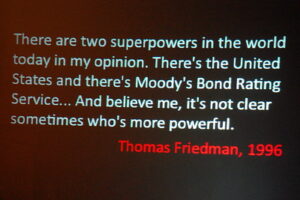As Americans struggle to manage the impacts of high inflation, many community colleges have responded sympathetically by freezing tuition. If community colleges are going to restrict their revenues voluntarily, they must also commit to reducing expenses.
Inflation doesn’t just appear, and it doesn’t just vanish, either. Because of the way the Fed manages monetary policy, inflation could remain high through 2024. For Michigan community colleges, this poses a real problem.
Proposal A capped the rise in property values to 5% or the rate of inflation, whichever is less. When inflation rises beyond 5% – as it has done for several months in a row – institutions bear the rising costs of goods and services, construction materials, fuel, supplies, energy, insurance, and wages and benefits. Adding to this is the possibility that the housing market is in a bubble, and record-high property values could see a major correction in the coming months. Were housing values to plummet – as they did during the Great Recession – that could impact property tax collections for years.
While property tax collections could rise by 5% in 2023 or 2024, inflation could rise by 10% or more. That would leave institutions with few good options. Drawing down on the school’s “rainy day fund” could offset the rise in costs for a time – depending upon how large the institution’s reserve is.
Cutting expenses is necessary during high inflation
In this circumstance, increasing revenues is unlikely. State law limits the college’s largest major revenue stream – property tax revenues. And because of the way the cap applies, prolonged high inflation could result in chronic revenue shortages. If the college has adopted a tuition freeze, the college itself has voluntarily limited its second-largest revenue stream. What happens to the third-largest revenue stream – the state appropriation – is mostly out of the community college’s control. The remaining revenue streams are comparatively minor, and economic conditions may render them unreliable.
The only open option is to cut expenses. Cutting expenses is rarely a bad idea, but in this situation it’s a necessity. In these conditions, it is a non-negotiable requirement. Cutting expenses may mean not filling open positions; laying off personnel; postponing unnecessary construction projects; limiting purchases; reducing energy consumption; renegotiating contracts; and refinancing outstanding loans, if that’s a desirable possibility.
Austerity measures may need to remain in place for a couple of years, until rising inflation and capped revenue streams settle. In other words, it’s not the time to hire a new crop of Vice Presidents or extend the President’s contract through 2045. It is not time to borrow money or issue bonds, either.
It is time to take a rational approach to tuition increases. Freezing tuition indefinitely – especially when inflation is approaching double-digits – is unwise and unsustainable. It is a setup for future financial problems for both students and the institution. It is also time to eliminate the subsidy that Washtenaw County taxpayers have so generously (and unwillingly) provided for out-of-district students who take classes online.
Photo Credit: 401, via Flickr401(k) 2012

























